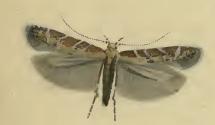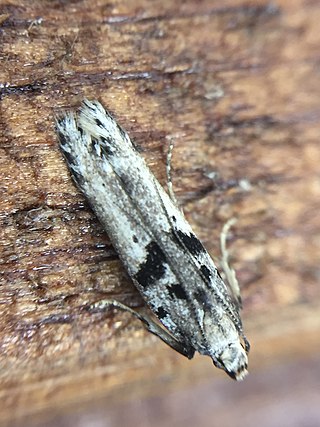
Aristotelia is a genus of moths in the family Gelechiidae. Well-known species are food plant specialists, and diverse hosts are used – Salicaceae, Solanaceae, Rosaceae, Fagaceae, Fabaceae, Asteraceae.

Aristotelia roseosuffusella, the pink-washed aristotelia, clover aristotelia moth or garden webworm, is a moth in the family Gelechiidae. It is found in North America, including Alabama, Georgia, Illinois, Kentucky, Maryland, Massachusetts, Michigan, New Jersey, Oklahoma, Ontario, South Carolina, Tennessee and Virginia. The species was first described by James Brackenridge Clemens in 1860.

Aristotelia brizella is a moth of the family Gelechiidae. It is found in most of Europe, except Ireland, Switzerland and most of the Balkan Peninsula. Outside of Europe, it is found in North Africa and the Near East.

Aristotelia baltica is a moth of the family Gelechiidae. It is found in Bosnia and Herzegovina, the Baltic region and Russia. The range extends to the Russian Far East.
Aristotelia calastomella is a moth of the family Gelechiidae. It is found in Hungary, Ukraine and Russia, as well as on Cyprus. The habitat consists of meadows with Glycyrrhiza glabra and Limonium gmelini.
Aristotelia coeruleopictella is a moth of the family Gelechiidae. It is found in the Russian Far East.
Aristotelia decoratella is a moth of the family Gelechiidae. It is found in Portugal, France, Italy, Switzerland, Germany, Hungary, Slovakia, Bulgaria, Russia, as well as on Sardinia, Corsica and Sicily. It is also present in Asia Minor.
Aristotelia billii is a moth of the family Gelechiidae. It is found in France.
Aristotelia frankeniae is a moth of the family Gelechiidae. It is found in Spain and on Corsica.

Aristotelia heliacella is a moth of the family Gelechiidae. It is found in France, Switzerland, Austria, Germany, Italy, Finland, Norway and Sweden.
Aristotelia leonhardi is a moth of the family Gelechiidae. It is found in Austria.
Aristotelia mirabilis is a moth of the family Gelechiidae. It is found in Portugal, Ukraine, Russia and Turkey.
Aristotelia montarcella is a moth of the family Gelechiidae. It is found in Spain.
Aristotelia pancaliella is a moth of the family Gelechiidae. It is found in Russia and Turkey.
Aristotelia staticella is a moth of the family Gelechiidae. It is found in France, Portugal and Ukraine, as well as on Sardinia.

Aristotelia subdecurtella, the brown fen neb, is a moth of the family Gelechiidae. It is found in most of Europe, except Norway, Belgium, Spain, Switzerland, the Czech Republic and most of the Balkan Peninsula. It is also found in the Russian Far East. The habitat consists of wetland areas.

Aristotelia subericinella is a moth of the family Gelechiidae. It is found in southern and eastern Europe, The Ural Mountains, Turkey and Central Asia.

Anomologinae is a subfamily of moths in the family Gelechiidae.
Aristotelia ochroxysta is a moth of the family Gelechiidae. It was described by Edward Meyrick in 1929. It is found in North America, where it has been recorded from Texas.

Aristotelia paradesma is a moth of the family Gelechiidae. It was described by Edward Meyrick in 1885 and is endemic to New Zealand. This species has been observed on both the North and South Islands. The larvae feed on Coprosma species creating and living in stem galls. The adults are on the wing from November to March and are attracted to light.








